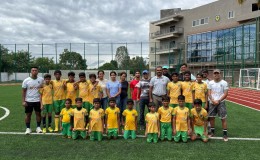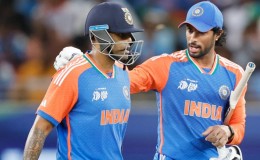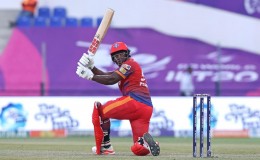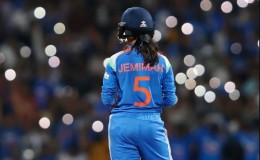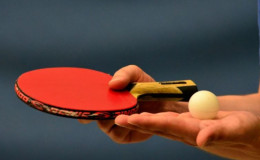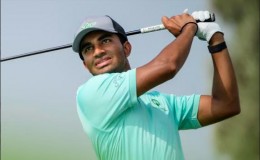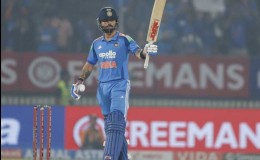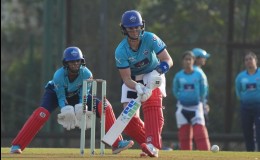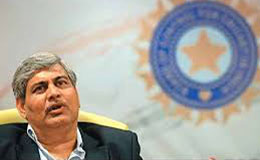 Edinburgh: During its 2016 ICC Annual Conference which concluded on Saturday in Edinburgh with the ICC, IDI and IBC Board meetings held under the chairmanship of Shashank Manohar, the ICC approved a change to the DRS playing condition relating to the LBW “Umpire’s Call”. The size of the zone inside which half the ball needs to hit for a Not Out decision to be reversed to Out will increase, changing to a zone bordered by the outside of off and leg stumps, and the bottom of the bails (formerly the centre of off and leg stumps, and the bottom of the bails).
Edinburgh: During its 2016 ICC Annual Conference which concluded on Saturday in Edinburgh with the ICC, IDI and IBC Board meetings held under the chairmanship of Shashank Manohar, the ICC approved a change to the DRS playing condition relating to the LBW “Umpire’s Call”. The size of the zone inside which half the ball needs to hit for a Not Out decision to be reversed to Out will increase, changing to a zone bordered by the outside of off and leg stumps, and the bottom of the bails (formerly the centre of off and leg stumps, and the bottom of the bails).
This amendment will come into effect from 1 October (or from the start of any series using DRS that commences just prior to this date).
No balls
There was discussion about the calling of No balls, and the ICC will arrange a trial over coming months to better understand whether the third umpire could use instant replays to call No balls more accurately. The trial is likely to be staged during one of the upcoming ODI series, and the third umpire will judge No balls within a few seconds of the ball being delivered and communicate this to the on-field umpire. Further details relating to the trial will be announced once finalised.
Helmet Safety
The ICC reiterated its position that the wearing of helmets in international cricket should not be mandatory, but that if a player decides to wear a batting helmet, then it must comply with the new British Standard (BS) - BS7928:2013.
There was concern that there were too many international cricketers not wearing BS compliant helmets, and that this needed to be more tightly regulated by the ICC. It was agreed that Members will educate their players on the benefits of using BS compliant helmets, and the ICC Clothing and Equipment Regulations will be amended to reflect the decision that only BS compliant helmets may be worn when batting in international matches.
“The discretion of wearing a helmet continues to rest with the player, but if a player decides to wear a helmet then it has to be one which complies with the British Standard specifications. This is part of ICC’s duty of care to prevent a player from picking up a serious injury as a result of a misperception that the helmet being worn is safe,” said Richardson.
Other matters
The Chairman of the Anti-Corruption Unit, Sir Ronnie Flanagan, provided an annual update, including the progress made on the implementation of the Integrity Working Party recommendations, which were approved during last year’s ICC Annual Conference in Barbados.
The Board also approved the extension of the ICC Chief Executive’s contract, with Richardson agreeing to continue in the role through to the end of 2019 ICC Annual Conference.
Cricket Scotland thanked
Manohar described the 2016 Annual Conference as a huge success and thanked Cricket Scotland for hosting the summit. “It has been a memorable gathering with many highlights throughout the week as well as being a highly productive period for all of the administrators in many ways. With the overarching aim to make cricket The World’s Favourite Sport, we have addressed and tackled a number of important matters, strengthened old relationships and made new friendships.
“Some of the most significant projects remain work in progress but they are complex and require considerable attention and thought. Even in these areas, we have made big strides and I remain confident and optimistic that we will conclude that work as quickly as possible.
“On behalf of the entire cricket family, I want to thank Cricket Scotland for hosting this year’s Annual Conference in Edinburgh and for being an outstanding host. I wish Cricket Scotland all the very best both on and off the field,” said Manohar.
The ICC Board consists of the nominated representatives of each of the 10 Full Members plus three elected Associate Member representatives. The meeting is chaired by the ICC Chairman and also present is the ICC Chief Executive.
The ICC Chief Executives’ Committee comprises the Chief Executives of the 10 Full Members as well as three Associate Member representatives. Also present is the ICC Chief Executive who chairs the meeting, and, by invitation, the ICC Chairman, the Chairman of the ICC Cricket Committee and the Chair of the ICC Women’s Committee.

